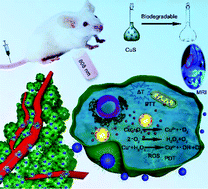A highly active (102) surface-induced rapid degradation of a CuS nanotheranostic platform for in situ T1-weighted magnetic resonance imaging-guided synergistic therapy†
Abstract
Polyvinylpyrrolidone-modified CuS nanocrystals (CuS NCs) with high photothermal conversion efficiency (46%) and pH and near-infrared (NIR) light-triggered degradation properties are a promising nanotheranostic platform for in situ magnetic resonance imaging (MRI)-guided synergistic photothermal and photodynamic therapy. On the one hand, the (102) surface of CuS NCs has a small bandgap based on density functional theory, which leads to high photothermal conversion efficiency. On the other hand, the S vacancy formation energy of the (102) surface is favourable. On entry into tumor cells through endocytosis, the S2− ions on the (102) surface of CuS NCs can be easily oxidized under the tumor microenvironment and 808 nm laser irradiation; then, a large amount of Cu+ ions can be released from CuS NCs and accelerate the degradation of nanocrystals. Cu+ ions can generate reactive oxygen species (ROS) under the tumor microenvironment and 808 nm laser irradiation. Meanwhile, the oxidation product Cu2+ ions can be generated from the oxidized Cu+ ions and applied for in situ T1-weighted magnetic resonance imaging. Moreover, the biodegradable CuS NCs possess a high tumor uptake and can be rapidly excreted with a low long-term retention/toxicity. Therefore, degradable and multifunctional CuS NCs are a safe and efficient candidate for the diagnosis and treatment of cancer.

- This article is part of the themed collection: 2019 Nanoscale HOT Article Collection


 Please wait while we load your content...
Please wait while we load your content...